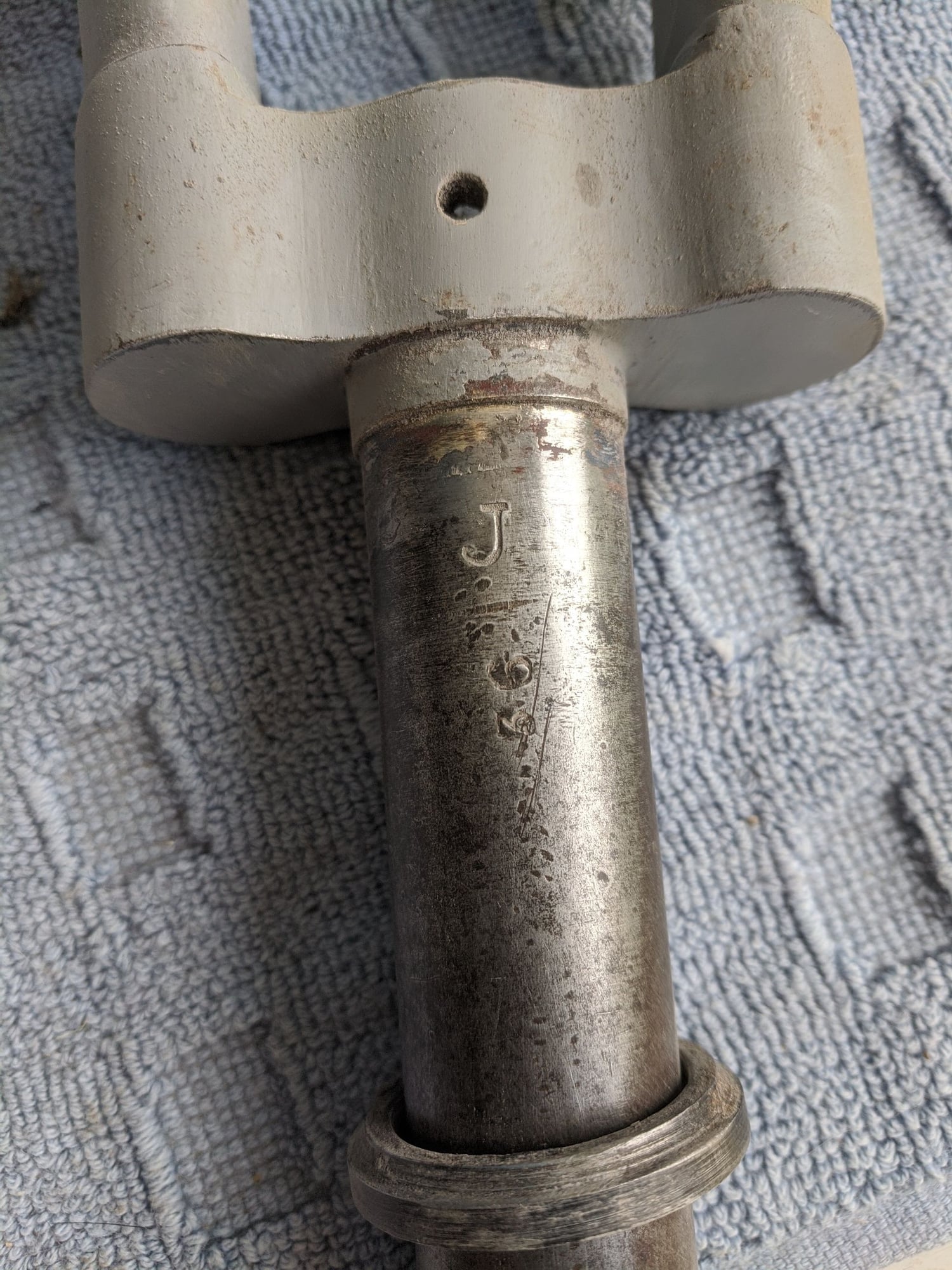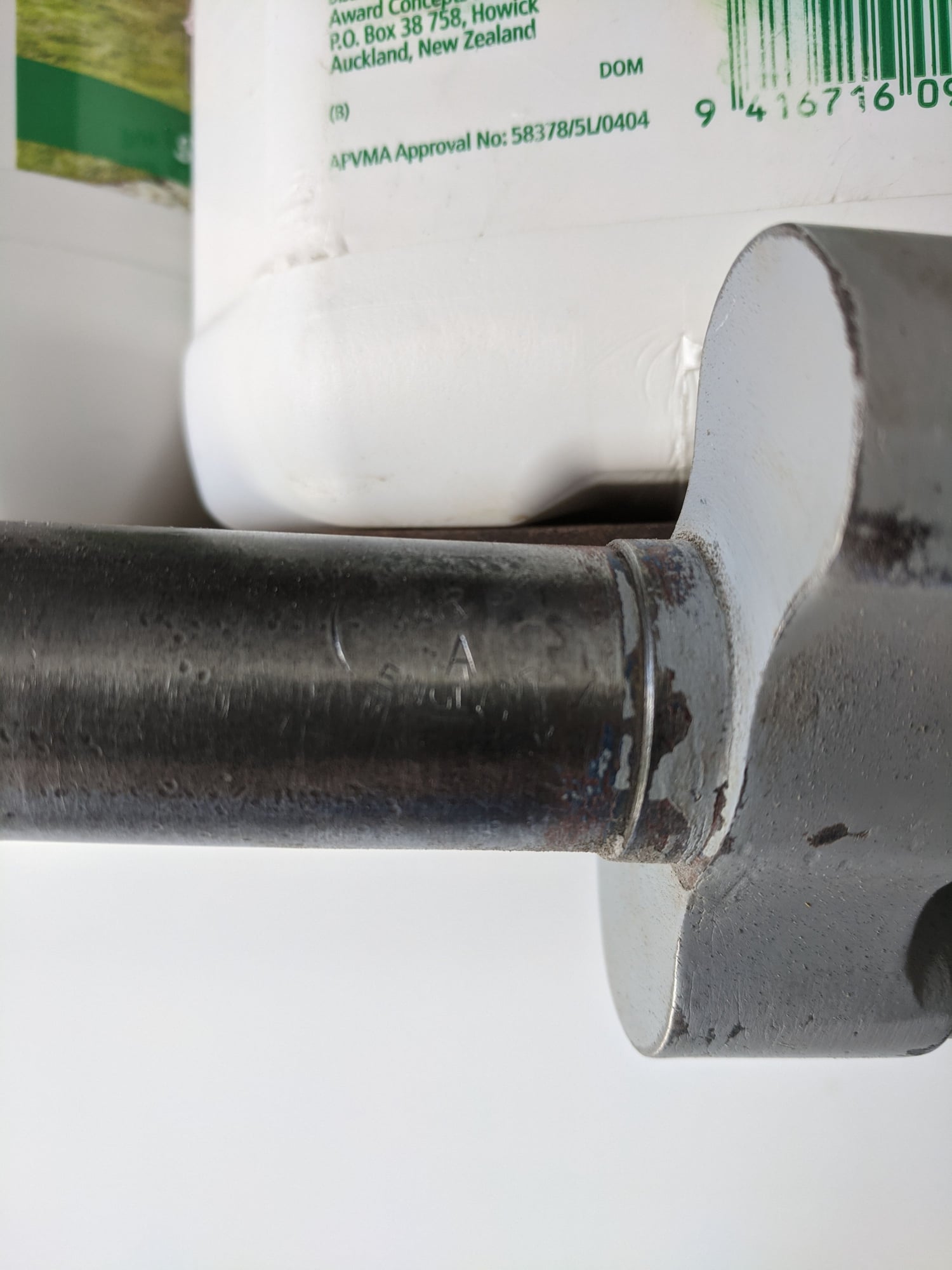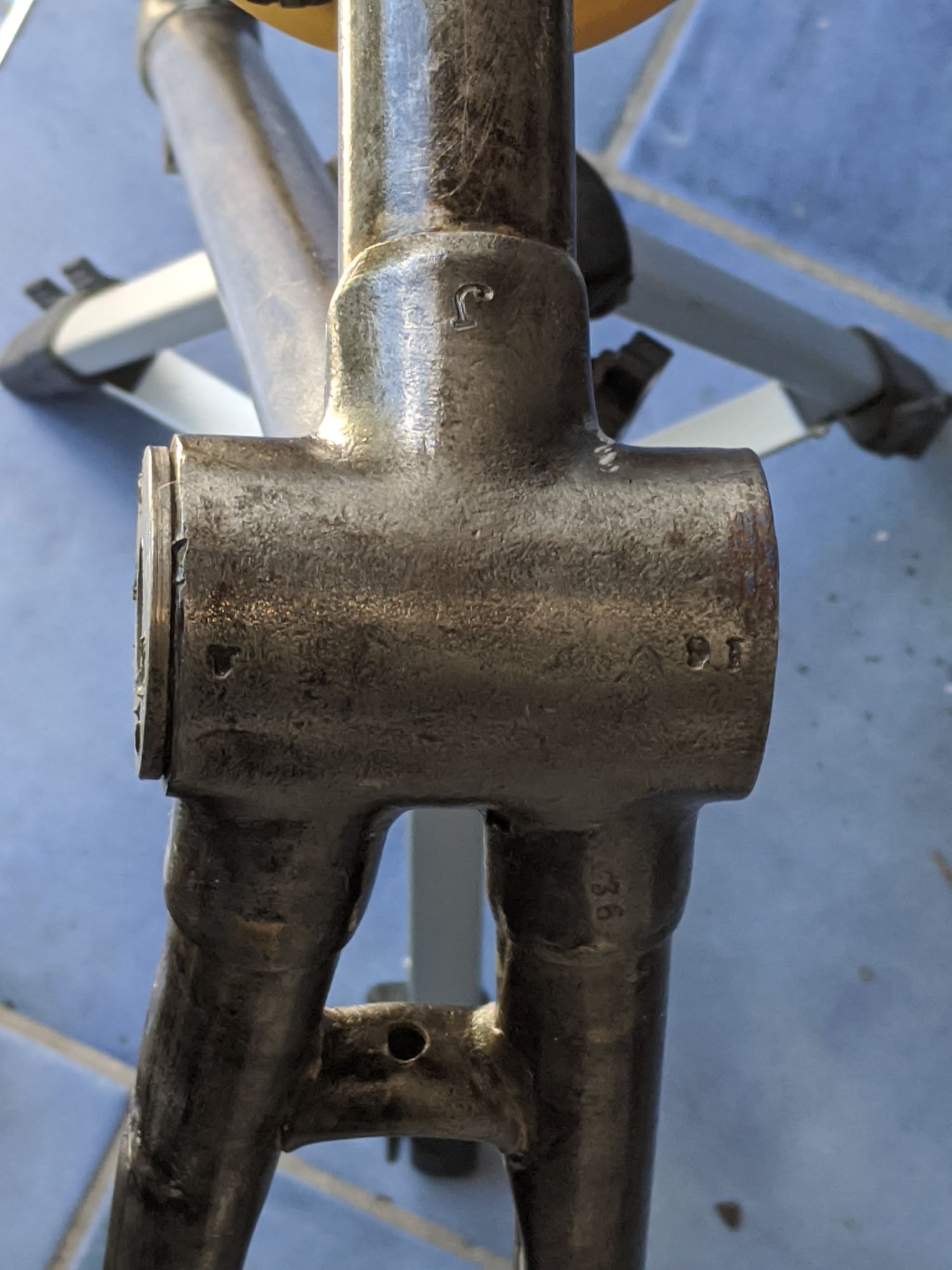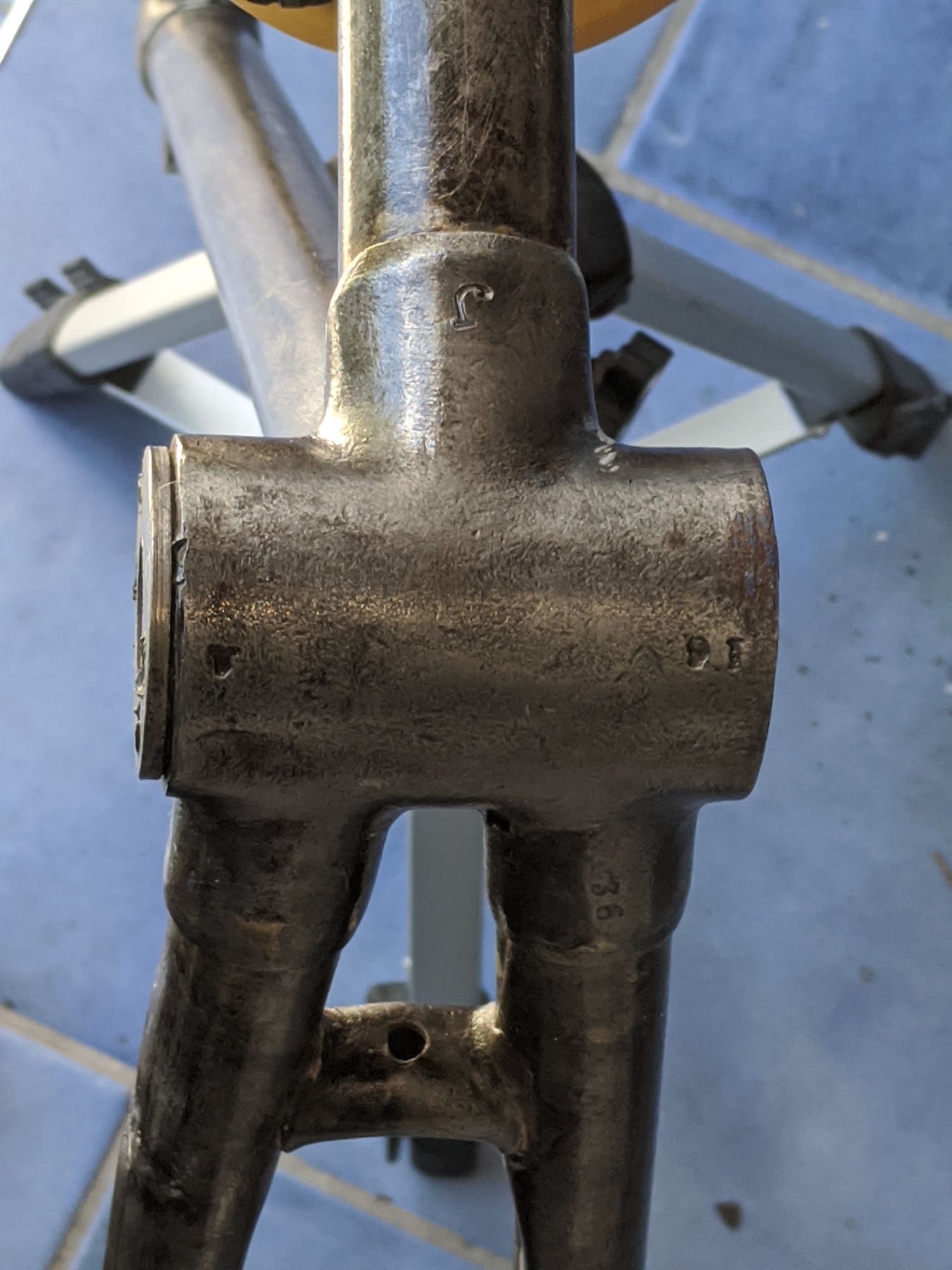Accles and Pollock - tube gauges
#1
Junior Member
Thread Starter
Join Date: Oct 2018
Location: ...small island...
Posts: 87
Mentioned: 0 Post(s)
Tagged: 0 Thread(s)
Quoted: 26 Post(s)
Liked 113 Times
in
43 Posts
Accles and Pollock - tube gauges
Hello,
I'm trying to find out what gauges Accles and Pollock Kromo tubes were drawn to, and struggling to find any information. I have a 22" 1950s frameset that is weighing as 4.13 pounds for the painted frame, and 1.53 pounds for the painted fork. The tubing is not known.
Some Kromo frame owners have recorded frame weights lower than 531 and other steel frames of the time.
Also, what was the distinction between Kromo and Kromo SAQ? I've seen a fork steerer stamping with AQ interpreted as 'A 'class quality - would SAQ be related to this?
All responses and advice appreciated.
Thanks
I'm trying to find out what gauges Accles and Pollock Kromo tubes were drawn to, and struggling to find any information. I have a 22" 1950s frameset that is weighing as 4.13 pounds for the painted frame, and 1.53 pounds for the painted fork. The tubing is not known.
Some Kromo frame owners have recorded frame weights lower than 531 and other steel frames of the time.
Also, what was the distinction between Kromo and Kromo SAQ? I've seen a fork steerer stamping with AQ interpreted as 'A 'class quality - would SAQ be related to this?
All responses and advice appreciated.
Thanks
#2
Member
Join Date: Nov 2014
Location: Christchurch New Zealand
Posts: 48
Bikes: MKM., F. A. Lipcombe, Schwinn King Sting, 1938 BSA
Mentioned: 1 Post(s)
Tagged: 0 Thread(s)
Quoted: 8 Post(s)
Liked 0 Times
in
0 Posts
Accles and Pollack tube gauges
Hello,
I'm trying to find out what gauges Accles and Pollock Kromo tubes were drawn to, and struggling to find any information. I have a 22" 1950s frameset that is weighing as 4.13 pounds for the painted frame, and 1.53 pounds for the painted fork. The tubing is not known.
Some Kromo frame owners have recorded frame weights lower than 531 and other steel frames of the time.
Also, what was the distinction between Kromo and Kromo SAQ? I've seen a fork steerer stamping with AQ interpreted as 'A 'class quality - would SAQ be related to this?
All responses and advice appreciated.
Thanks
I'm trying to find out what gauges Accles and Pollock Kromo tubes were drawn to, and struggling to find any information. I have a 22" 1950s frameset that is weighing as 4.13 pounds for the painted frame, and 1.53 pounds for the painted fork. The tubing is not known.
Some Kromo frame owners have recorded frame weights lower than 531 and other steel frames of the time.
Also, what was the distinction between Kromo and Kromo SAQ? I've seen a fork steerer stamping with AQ interpreted as 'A 'class quality - would SAQ be related to this?
All responses and advice appreciated.
Thanks
I am interested to know the A&P number stamped on the steerer tube and possibly the BB on your frame.
This is a small list of frames numbers presumed to mean the frame set number?A&P set number Maker Maker SN year Owner reference on steerer tube and BB
11 B quality Speedy cycles 1946 1914 A NZ
36 A quality ? Christchurch NZ 16? 1916? Les NZ
Z12219 S Sport Speedwell Australia A57584 Jan 1939 on the BB Flying dragon
95112 A quality ? UK ? 1950? ?
The more of these numbers the better the identification of the years involved.
Regards
crumbling
#3
Senior Member
Join Date: Nov 2004
Posts: 23,223
Mentioned: 656 Post(s)
Tagged: 1 Thread(s)
Quoted: 4722 Post(s)
Likes: 0
Liked 3,039 Times
in
1,877 Posts
Hello,
I'm trying to find out what gauges Accles and Pollock Kromo tubes were drawn to, and struggling to find any information. I have a 22" 1950s frameset that is weighing as 4.13 pounds for the painted frame, and 1.53 pounds for the painted fork. The tubing is not known.
Some Kromo frame owners have recorded frame weights lower than 531 and other steel frames of the time.
Also, what was the distinction between Kromo and Kromo SAQ? I've seen a fork steerer stamping with AQ interpreted as 'A 'class quality - would SAQ be related to this?
All responses and advice appreciated.
Thanks
I'm trying to find out what gauges Accles and Pollock Kromo tubes were drawn to, and struggling to find any information. I have a 22" 1950s frameset that is weighing as 4.13 pounds for the painted frame, and 1.53 pounds for the painted fork. The tubing is not known.
Some Kromo frame owners have recorded frame weights lower than 531 and other steel frames of the time.
Also, what was the distinction between Kromo and Kromo SAQ? I've seen a fork steerer stamping with AQ interpreted as 'A 'class quality - would SAQ be related to this?
All responses and advice appreciated.
Thanks
#4
Senior Member
Join Date: Nov 2004
Posts: 23,223
Mentioned: 656 Post(s)
Tagged: 1 Thread(s)
Quoted: 4722 Post(s)
Likes: 0
Liked 3,039 Times
in
1,877 Posts
Likes For T-Mar:
#5
Member
Join Date: Nov 2014
Location: Christchurch New Zealand
Posts: 48
Bikes: MKM., F. A. Lipcombe, Schwinn King Sting, 1938 BSA
Mentioned: 1 Post(s)
Tagged: 0 Thread(s)
Quoted: 8 Post(s)
Liked 0 Times
in
0 Posts
T-Mar
This is not an oxymoron butt my understanding of butted tubing and its origin and inventor.
I have seen although Butted tubing existed from 1840 being tubing fabricated from flat sheet for gas supply to lighting of London streets as panted by Comenius Whitehouse who invented a better method for making metal tubes. This process, called the butt-weld process is the basis for our current pipe-making procedures. In his method, thin sheets of iron were cut to strips, heated and drawn through a cone-shaped opening. As the metal went through the opening, its edges curled up and created a pipe shape. The two edges were welded together to finish the pipe. This is the origin of Butted tubing in 1825.
Refer to Pipeline Equities - A Brief History of Steel Pipe
The Patent Butted Tube Company patent document in 1897 No 24931 states “The invention consists of improvements to seamless steel and other tubes” and does not claim inventing Butted tubing. Further “our object being readily produce such tubes with varying distribution of metal or with ends or other required parts of greater thickness than the body of the tubes.”
Further to this I have seen images of Accles amd Pollack in 1905 advertising their Best Butted Tubes
I have seen your statement that Accles and Pollack did not exist until mid 1900s but in fact established around 1900 specifically to make steel tubing for all types of use not cycling. The built the first steel tube aircraft , the Mayfly of John Seddon design that was not a huge success, watch at 8.42 minutes for the Mayfly portion of
. This shows what may have been A&P tube manufacturing. I have seen their advertised racing 1922 model frame sets.
My wish is to establish some credible evidence so I can date the frame I have.
This is not an oxymoron butt my understanding of butted tubing and its origin and inventor.
I have seen although Butted tubing existed from 1840 being tubing fabricated from flat sheet for gas supply to lighting of London streets as panted by Comenius Whitehouse who invented a better method for making metal tubes. This process, called the butt-weld process is the basis for our current pipe-making procedures. In his method, thin sheets of iron were cut to strips, heated and drawn through a cone-shaped opening. As the metal went through the opening, its edges curled up and created a pipe shape. The two edges were welded together to finish the pipe. This is the origin of Butted tubing in 1825.
Refer to Pipeline Equities - A Brief History of Steel Pipe
The Patent Butted Tube Company patent document in 1897 No 24931 states “The invention consists of improvements to seamless steel and other tubes” and does not claim inventing Butted tubing. Further “our object being readily produce such tubes with varying distribution of metal or with ends or other required parts of greater thickness than the body of the tubes.”
Further to this I have seen images of Accles amd Pollack in 1905 advertising their Best Butted Tubes
I have seen your statement that Accles and Pollack did not exist until mid 1900s but in fact established around 1900 specifically to make steel tubing for all types of use not cycling. The built the first steel tube aircraft , the Mayfly of John Seddon design that was not a huge success, watch at 8.42 minutes for the Mayfly portion of
My wish is to establish some credible evidence so I can date the frame I have.
#9
Senior Member
Join Date: Nov 2004
Posts: 23,223
Mentioned: 656 Post(s)
Tagged: 1 Thread(s)
Quoted: 4722 Post(s)
Likes: 0
Liked 3,039 Times
in
1,877 Posts
T-Mar
This is not an oxymoron butt my understanding of butted tubing and its origin and inventor.
I have seen although Butted tubing existed from 1840 being tubing fabricated from flat sheet for gas supply to lighting of London streets as panted by Comenius Whitehouse who invented a better method for making metal tubes. This process, called the butt-weld process is the basis for our current pipe-making procedures. In his method, thin sheets of iron were cut to strips, heated and drawn through a cone-shaped opening. As the metal went through the opening, its edges curled up and created a pipe shape. The two edges were welded together to finish the pipe. This is the origin of Butted tubing in 1825....
This is not an oxymoron butt my understanding of butted tubing and its origin and inventor.
I have seen although Butted tubing existed from 1840 being tubing fabricated from flat sheet for gas supply to lighting of London streets as panted by Comenius Whitehouse who invented a better method for making metal tubes. This process, called the butt-weld process is the basis for our current pipe-making procedures. In his method, thin sheets of iron were cut to strips, heated and drawn through a cone-shaped opening. As the metal went through the opening, its edges curled up and created a pipe shape. The two edges were welded together to finish the pipe. This is the origin of Butted tubing in 1825....
I'm well aware that A&P goes back to the very early 20th century. If you look at my other posts you'll see my mention of their butted CrMo tubesets in the early 1930s and that CCM was using A&P as early as 1911. So, if I made such a statement, it is in error. Please direct me to the statement so that I may correct it.
Likes For T-Mar:
#10
Member
Join Date: Nov 2014
Location: Christchurch New Zealand
Posts: 48
Bikes: MKM., F. A. Lipcombe, Schwinn King Sting, 1938 BSA
Mentioned: 1 Post(s)
Tagged: 0 Thread(s)
Quoted: 8 Post(s)
Liked 0 Times
in
0 Posts
T-Mar
This discussion could be considered correct either way, yes the Whitehouse was called Butt-weld and The Patent Butted Tubing Company patent document in 1897 No 24931 states “The invention consists of improvements to seamless steel and other tubes” and does not claim inventing Butted tubing nor is Butted Tubing stated in that Patent document as it probably would not have been allowed at the time as another Patent was already in force. Thus Reynolds claim to inventing is only for the process of improvements to seamless steel and other tubes, surely a less confusing, original name could been applied.
My original statement of "The frame tubing is the butted type with a constant wall thickness (not thinning at the centres) on all tubes." This is a correct as it is clarifies the original request by evacReynolds531 to find "gauges Accles and Pollock Kromo tubes were drawn to.
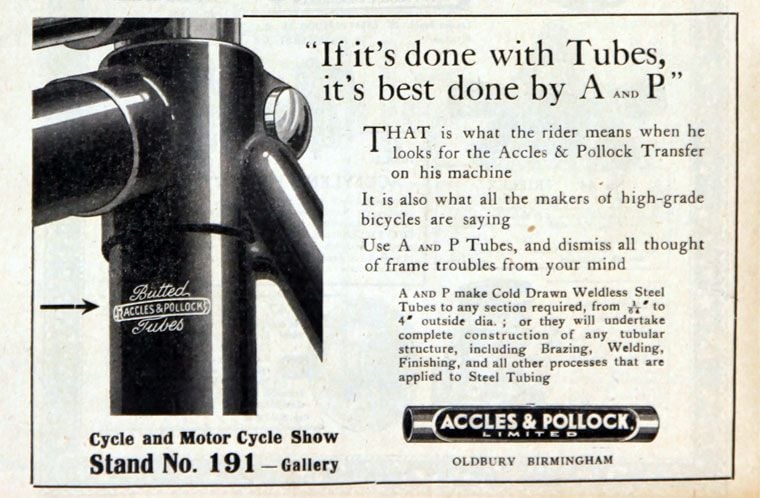
" Butting" by Reynolds meaning is the "improvements to seamless steel and other tubes” ie wall thickness. A&P do state they use the Butted tubing in at least 1905 from what I have seen. Maybe Reynolds Patent had expired or A&P paid a royalty to use it or Reynolds did not have a claim to the "Butted" naming.

This is the origin of what is confusing to you.
crumbling
This discussion could be considered correct either way, yes the Whitehouse was called Butt-weld and The Patent Butted Tubing Company patent document in 1897 No 24931 states “The invention consists of improvements to seamless steel and other tubes” and does not claim inventing Butted tubing nor is Butted Tubing stated in that Patent document as it probably would not have been allowed at the time as another Patent was already in force. Thus Reynolds claim to inventing is only for the process of improvements to seamless steel and other tubes, surely a less confusing, original name could been applied.
My original statement of "The frame tubing is the butted type with a constant wall thickness (not thinning at the centres) on all tubes." This is a correct as it is clarifies the original request by evacReynolds531 to find "gauges Accles and Pollock Kromo tubes were drawn to.

" Butting" by Reynolds meaning is the "improvements to seamless steel and other tubes” ie wall thickness. A&P do state they use the Butted tubing in at least 1905 from what I have seen. Maybe Reynolds Patent had expired or A&P paid a royalty to use it or Reynolds did not have a claim to the "Butted" naming.

This is the origin of what is confusing to you.
crumbling
#11
Senior Member
Join Date: Jun 2004
Location: Torrance, CA
Posts: 3,061
Bikes: Homebuilt steel
Mentioned: 18 Post(s)
Tagged: 0 Thread(s)
Quoted: 2202 Post(s)
Liked 426 Times
in
338 Posts
I don't have anything to add regarding Accles and Pollock bike tubing, what I do know is that they also made golf club shafts. Arnold Palmer's club company used them as their stock offering on some models which is where I became familiar with them. High quality shafts which later were sold under the "Apollo" brand. Good stuff.
#12
Senior Member
Join Date: Nov 2004
Posts: 23,223
Mentioned: 656 Post(s)
Tagged: 1 Thread(s)
Quoted: 4722 Post(s)
Likes: 0
Liked 3,039 Times
in
1,877 Posts
... yes the Whitehouse was called Butt-weld and The Patent Butted Tubing Company patent document in 1897 No 24931 states “The invention consists of improvements to seamless steel and other tubes” and does not claim inventing Butted tubing nor is Butted Tubing stated in that Patent document as it probably would not have been allowed at the time as another Patent was already in force. Thus Reynolds claim to inventing is only for the process of improvements to seamless steel and other tubes, surely a less confusing, original name could been applied....

As a result of the granting of this patent, a new company, The Patent Butted Tubes Co. Ltd. was incorporated. The patent, in conjunction with the name of the company and its prime product, established the definition of butted in the lexicon of the bicycle industry (i.e. a butted tube is a tube with one or two thicker ends).
Accles and Pollock subscribed to the same definition. This is why their advertisements for butted showed a partially cut away tube. Look closely at the 1905 advertisement and you'll see that the tube has a thicker wall at the ends, starting above the 'A' and 'K' in the company name.
This definition is used by all bicycling tubing manufacturers. In the bicycle tubing industry you can't have butted tubing of constant thickness. It is an oxymoron.

...My original statement of "The frame tubing is the butted type with a constant wall thickness (not thinning at the centres) on all tubes." This is a correct as it is clarifies the original request by evacReynolds531 to find "gauges Accles and Pollock Kromo tubes were drawn to..

..." Butting" by Reynolds meaning is the "improvements to seamless steel and other tubes” ie wall thickness. A&P do state they use the Butted tubing in at least 1905 from what I have seen. Maybe Reynolds Patent had expired or A&P paid a royalty to use it or Reynolds did not have a claim to the "Butted" naming.
This is the origin of what is confusing to you.
This is the origin of what is confusing to you.
Likes For T-Mar:
#13
Newbie
Join Date: Mar 2022
Posts: 1
Mentioned: 0 Post(s)
Tagged: 0 Thread(s)
Quoted: 0 Post(s)
Likes: 0
Liked 0 Times
in
0 Posts
Kromo tubing
Can anyone tell me what seat pin fits Kromo SAQ? I know I can measure the internal diameter of the seat tube, but that does not necessarily tell me what the frame tubing is. My frame is 26.8 mm . This indicates 531 plain gauge, but the frame minus forks weighs only 1.8kg, so I'm wondering if it could be Kromo.





